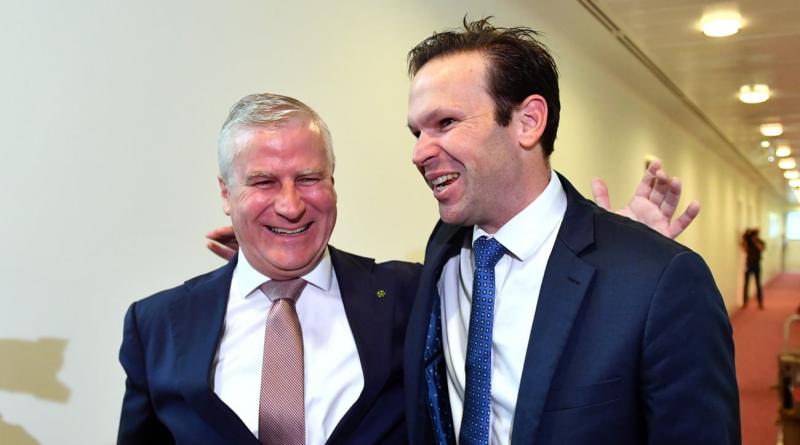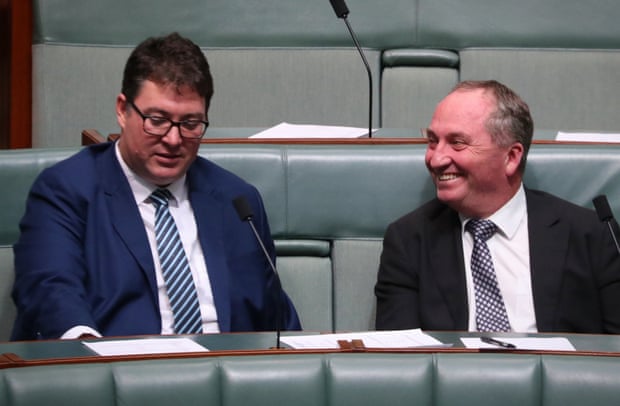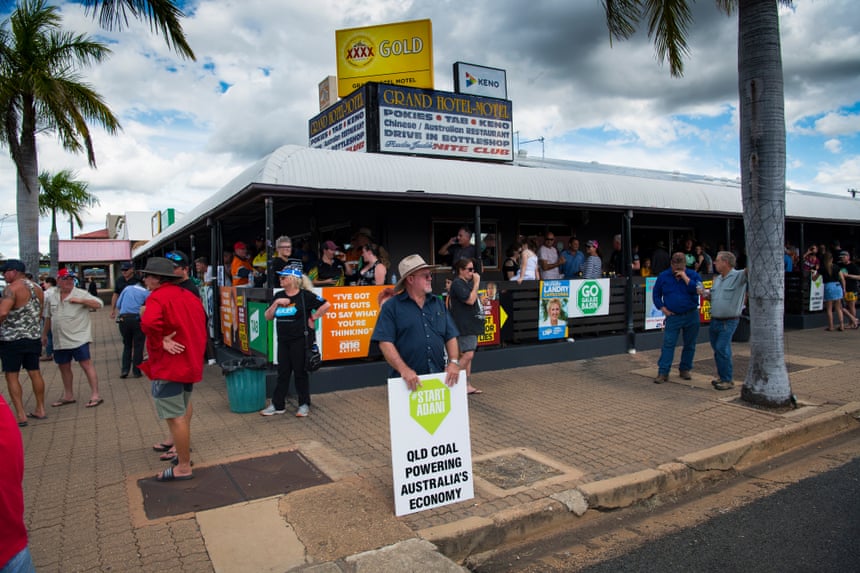Forgotten farmers, mining and anti-green invective: how the Nationals became a party for coal.

In this extract from her Quarterly Essay, Judith Brett says mining has offered the Nationals a way to supplement their declining agricultural base
At the gala dinner in March this year to celebrate the centenary of the Nationals, federal president Larry Anthony boasted that the party played a key role in twice removing Malcolm Turnbull because of his climate change policy.
The Coalition had won the 2019 election against the odds, but not the seat of Richmond on the north coast of New South Wales, which had voted three generations of the Anthony family into parliament, including Larry. The demography of this once predominantly agricultural area has shifted, with sea-changers and alternatives moving into the coastal towns, and the seat has been held by Labor since 2004 with substantial support from the Greens. To survive, the Nationals needed new supporters and they were finding them in the coalminers of central Queensland. Whatever the contribution Bill Shorten’s unpopularity, franking credits or negative gearing may have made to the Coalition winning in 2019, the brutal truth is that Labor lost the election in Queensland and it lost it in large part because of the Queensland Liberal National party’s successful weaponising of coal.
When he was forced to stand aside in mid-2017 because of doubts about his mother’s citizenship, Queensland Nationals senator Matt Canavan posted an extraordinary statement on Facebook: “It has been such an honour to represent the Australian mining sector over the past year. It is an industry full of fine, hard-working and innovative people. Mining and resources are a uniquely Australian success story. From the small, gambling explorers and prospectors to the large, world-beating multinationals, the industry provides rich and diverse experiences that can take you to the smallest towns of outback Australia to the biggest cities in the world.” Nowhere did he mention the farmers his party was formed to serve, nor that many farmers are challenging mining’s social licence, fighting tooth and nail to protect their agricultural land from mining.
The National party’s leadership has close links to the resources industry. Past leaders Mark Vaile and John Anderson made fortunes out of resources after leaving politics; Matt Canavan’s brother John is an enthusiastic investor in Queensland coal assets; Larry Anthony has lobbied for the Chinese mining giant Shenhua’s Watermark coalmine on the edge of the Liverpool Plains in NSWs, which is opposed by the local farming communities. In March 2019, on Channel Ten’s The Project, Waleed Aly asked Nationals leader Michael McCormack: “Could you name a single, big policy area where the Nats have sided with the interests of farmers over the interests of miners when they come into conflict?” Off the top of his head, McCormack could not name one.
The National party has become the party of coal. Turnbull tells in his memoir A Bigger Picture of a meeting that included the Nationals’ George Christensen, Keith Pitt, Barnaby Joyce and Andrew Gee, who were arguing that a new coal-fired power station would deliver cheaper power. “OK, I asked, what coal price are you assuming? They didn’t know. How much coal will the new coal plant use for each megawatt hour? Again they didn’t know. How much do you think the new plant will cost? No idea. I was patient and polite as I explained the economics of a new coal-fired power station and how it was no longer competitive with renewables plus storage to deliver dispatchable power. They weren’t convinced.”

No doubt they were infuriated by Turnbull’s somewhat condescending interrogation, but, as Bridget McKenzie told him on the way out, “You can’t reason with them, PM. It’s religion. They don’t care about the numbers.” But they do care about electoral numbers.
The National party’s political power depends on the geographical concentration of its vote. At the 2019 election, it won a little less than 7% of first-preference votes, if we attribute to it a quarter of the vote of the Queensland Liberal National party (LNP), which was formed in 2008 from a merger of the Queensland branches of the two parties. With this vote, the Nationals won 15 seats. By contrast, the Greens’ nation-wide first-preference vote of more than 10% is diffused across electorates, and they have only one lonely representative in the House of Representatives. As another geographically concentrated activity, mining offers the Nationals a tantalising way to supplement their declining agricultural electoral base.
In the weeks before the 2019 election, Bob Brown led a convoy to #StopAdanithrough central Queensland that was met with jeering hostility, enabling the LNP to mobilise regional loyalties. Shorten equivocated on whether or not Labor would review the coalmine’s environmental approval if it won government, sowing distrust among both supporters and opponents of the mine. Making Adani a key electoral issue was the last thing Labor needed as it tried to reconcile environmentally concerned city voters with regional voters who believed their economic futures depended on coalmining. It couldn’t be done, so the best thing for Labor was to keep voters’ minds focused on issues like health and education. Instead, Shorten kept being asked where he stood on Adani and was never able to give a clear answer. Clive Palmer, who has substantial coal interests in the Galilee Basin, spent $60m on advertising his United Australia party. Although the party won no seats, Palmer was well satisfied with the result. His Shifty Shorten ads, he said, had succeeded in preventing a Labor victory.

In all states and territories except for Queensland and Western Australia, Labor plus left independents won the majority of seats. In Western Australia, Labor won only five to the Coalition’s 11, the same as in 2016, but in Queensland it lost two seats, leaving it with only six of the state’s 30 seats. As well, sitting LNP members enjoyed massive swings. “I never expected numbers like these,” Michelle Landry told the ABC on election night. “Thank you, Bob Brown, is all I can say. He came up here trying to tell Queenslanders what we should and shouldn’t be doing, and it actually drew together the agricultural and mining sectors.”
Landry is the member for Capricornia, which stretches along the coast from Rockhampton in the south to the southern suburbs of Mackay. In the north and west it includes major mining centres such as the coalmining town of Collinsville, where the LNP wants a new coal-fired power station built. For most of its history, Capricornia has been Labor. Landry won the seat in 2016 with a margin of just 0.6%. In 2019, the margin was 12.4%. The miners had deserted Labor, and not just in Queensland, but also in the NSW coalmining electorate of Hunter, where the primary vote of the sitting Labor member, Joel Fitzgibbon, dropped by almost 15%.
In Queensland, said Canavan, there had been “a hi-vis workers’ revolution”, with the extreme demands of climate change activists “pushing what have otherwise been strong Labor-voting areas towards the conservative side of politics”.

When the Country party was established to represent farmers and people living in country towns, it was informed by what the political scientist Don Aitkin called “country-mindedness,” the belief that country folk were more independent, hard-working and morally authentic than people living easy, pleasure-seeking lives in the cities. The self-indulgent Greens-voting inner city versus the hard-working regions is the most recent iteration of the opposition between city and country that has shaped Australian politics for at least 100 years.
Here is Canavan in February this year, a few days after he resigned from cabinet to support Joyce’s leadership challenge to McCormack: “Our wealth-producing industries, like farming, mining and manufacturing, have never been under greater attack. Farmers have had their land rights stripped off them, dams are stopped because of some snail or frog and mines get sabotaged by rich, city-based whingers who threaten and bully law-abiding businesses.”
Get it? Australia’s wealth is produced outside the cities and the cities are full of whingeing green bullies. This rhetoric is designed to pull regional voters back to the Nationals.
Canavan is fairly restrained. Fellow Queensland National George Christensen is the party specialist in anti-green invective. In 2014, he described environmentalists opposed to the expansion of Adani’s port at Abbot Point as “gutless green grubs”; in 2018, he posted a photo on Facebook of himself aiming a handgun with the caption, “You gotta ask yourself, do you feel lucky greenie punks.” Christensen draws on the anti-green invective in circulation since the battles in Tasmania over the forests.
As well as maintaining their political relevance, the Nationals’ specialisation in coal advocacy helps the Liberals, who can’t afford to be as openly hostile to environmentally concerned voters as the Nationals are. Like Labor, they are threatened by Greens and independents in city electorates. Independent Zali Steggall stood against Tony Abbott in Warringah on a platform of climate action and won.
The Queensland Nationals successfully weaponised coal in the 2019 election. Even though this was as much a strategy for the party’s political survival as it was a matter of conviction, it is further evidence of the fossil-fuel lobby’s success. Without Abbott, the Liberal party could not be relied on, but with the junior partner turning itself into the party of coal, fossil fuels could be sure of a seat at the cabinet table of a Coalition government.
This is an edited extract from Judith Brett’s Quarterly Essay 78, The Coal Curse: Resources, Climate and Australia’s Future, published this week
26 June 2020
The Guardian





